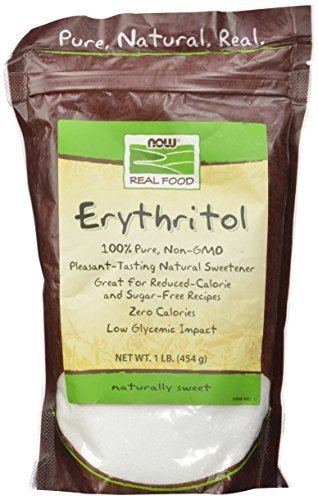Density 1.45 g/cm³ | ||
 | ||
Erythritol like sugar without the calories
Erythritol ((2R,3S)-butane-1,2,3,4-tetraol) is a sugar alcohol (or polyol) that has been approved for use as a food additive in the United States and throughout much of the world. It was discovered in 1848 by Scottish chemist John Stenhouse. It occurs naturally in some fruit and fermented foods. At the industrial level, it is produced from glucose by fermentation with a yeast, Moniliella pollinis. Erythritol is 60–70% as sweet as sucrose (table sugar) yet it is almost noncaloric, does not affect blood sugar, does not cause tooth decay, and is partially absorbed by the body, excreted in urine and feces. Under U.S. Food and Drug Administration (FDA) labeling requirements, it has a caloric value of 0.2 calories per gram (95% less than sugar and other carbohydrates), though nutritional labeling varies from country to country. Some countries, such as Japan and the United States, label it as zero-calorie, while the European Union currently labels it at 0 cal/g.
Contents
- Erythritol like sugar without the calories
- All about erythritol
- Erythritol and human digestion
- Side effects
- Production
- Heat of solution
- Blending for sugar like properties
- Erythritol and bacteria
- Obsolete synonyms from the 19th century
- References
All about erythritol
Erythritol and human digestion
In the body, most erythritol is absorbed into the bloodstream in the small intestine, and then for the most part excreted unchanged in the urine. About 10% enters the colon. Because 90% of erythritol is absorbed before it enters the large intestine, it does not normally cause laxative effects, as are often experienced after consumption of other sugar alcohols (such as xylitol and maltitol), although extremely large doses can cause nausea and borborygmi (stomach rumbling).
Side effects
In general, erythritol is free of side effects in regular use. Doses over 50 grams (1.8 oz) can cause a significant increase in nausea and stomach rumbling. Rarely, erythritol can cause allergic hives (urticaria).
When compared with other sugar alcohols, it is also much more difficult for intestinal bacteria to digest, so it is less likely to cause gas or bloating than other polyols, such as maltitol, sorbitol, or lactitol.
According to a study conducted in 2014, erythritol functions as an insecticide toxic to the fruit fly Drosophila melanogaster.
Production
Erythritol is produced industrially beginning with enzymatic hydrolysis of the starch from corn to generate glucose. Glucose is then fermented with yeast or another fungus to produce erythritol. Other methods such as electrochemical synthesis are in development.
Heat of solution
Erythritol has a strong cooling effect (endothermic, or positive heat of solution) when it dissolves in water, which is often combined with the cooling effect of mint flavors. The cooling effect is present only when erythritol is not already dissolved in water, a situation that might be experienced in an erythritol-sweetened frosting, chocolate bar, chewing gum, or hard candy. The cooling effect of erythritol is very similar to that of xylitol and among the strongest cooling effects of all sugar alcohols.
Blending for sugar-like properties
Erythritol is commonly used as a medium in which to deliver high-intensity sweeteners, especially stevia derivatives, serving the dual function of providing both bulk and a flavor similar to that of table sugar. Diet beverages made with this blend, thus contain erythritol in addition to the main sweetener. Beyond high-intensity sweeteners, erythritol is often paired with other bulky ingredients that exhibit sugar-like characteristics to better mimic the texture and mouthfeel of sucrose. The cooling effect of erythritol is rarely desired, hence other ingredients are chosen to dilute or negate that effect. Erythritol also has a propensity to crystallize and is not as soluble as sucrose, so ingredients may also be chosen to help negate this disadvantage. Furthermore, erythritol is not hygroscopic, meaning it does not attract moisture, which can lead to the drying out of products, in particular baked goods, if another hygroscopic ingredient is not used in the formulation.
Inulin is often combined with erythritol because of inulin's offering a complementary negative heat of solution (exothermic, or warming effect when dissolved, which helps cancel erythritol's cooling effect) and noncrystallizing properties. However, inulin has a propensity to cause gas and bloating in those having consumed it in moderate to large quantities, in particular in individuals unaccustomed to it. Other sugar alcohols are sometimes used with erythritol, in particular isomalt, because of its minimally positive heat of solution, and glycerin, which has a negative heat of solution, moderate hygroscopicity, and noncrystallizing liquid form.
Erythritol and bacteria
Erythritol is tooth-friendly; it cannot be metabolized by oral bacteria, so it does not contribute to tooth decay.
Erythritol is preferentially utilized by the Brucella bacteria spp. The presence of erythritol in the placentas of goats, cows, and pigs has been proposed as an explanation for the accumulation of Brucella bacteria found at these sites.
Obsolete synonyms from the 19th century
In the 19th and early 20th centuries, several synonyms were in use for erythritol: erythrol, erythcite, erythoglucin, eryglucin, erythromanite and phycite.
